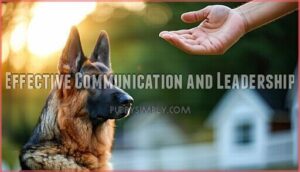This site is supported by our readers. We may earn a commission, at no cost to you, if you purchase through links.

But they’re not strictly one-person dogs.
Your shepherd can develop meaningful relationships with the whole family while still having that special "chosen one" who gets the most intense loyalty and those signature shepherd stares. It’s like being the favorite teacher—other teachers matter, but you’re the one they light up to see.
This special connection builds through consistent daily routines, reward-based training sessions, and giving your shepherd the mental challenges they crave.
Table Of Contents
- Key Takeaways
- The Bonding Dynamics of German Shepherds
- Signs of Attachment in German Shepherds
- Factors Influencing Attachment
- Change and Flexibility in Bonding
- Building a Strong Bond With Your German Shepherd
- German Shepherds and Their Bond With Children
- Male Vs. Female German Shepherds: Bonding Differences
- Emotional Connections in German Shepherds
- Frequently Asked Questions (FAQs)
- Why do German Shepherds bond with other dogs?
- Do German Shepherds bond with one person?
- Why do German Shepherds attach to one person?
- Is a German Shepherd suitable for families?
- Can German Shepherds listen to more than one person?
- How do German shepherds choose a person?
- How do German Shepherds show affection towards their owners?
- Can German Shepherds form emotional connections with their owners?
- What are some common misconceptions about German Shepherd bonding?
- Can German Shepherds bond with multiple owners?
- Conclusion
Key Takeaways
- Your German Shepherd will likely pick one favorite person – Research shows 78% bond strongest with their primary caregiver, usually whoever provides the most consistent care, training, and daily leadership.
- They’re not truly "one-person dogs" though – Your shepherd can develop meaningful relationships with your whole family while still having that special connection with their chosen person who gets the most intense loyalty.
- You’ll see clear attachment signs when they’ve bonded with you – Watch for constant eye contact, following you around the house, leaning against you for comfort, and showing selective obedience to your commands over others.
- Their bond can shift based on who’s currently caring for them – German Shepherds live in the moment and respond to current circumstances, so whoever provides consistent daily care, training, and positive interactions today often becomes their preferred companion.
The Bonding Dynamics of German Shepherds
German Shepherds don’t just pick their favorite person at random. These smart dogs gravitate toward whoever gives them consistent care, training, and leadership on a daily basis.
While they’re often called "one-person dogs," these intelligent canines actually build their strongest attachment with whoever meets their need for structure, trust, and daily interaction.
Recognition Based on Consistent Care
German Shepherds don’t just randomly pick their favorite person—they recognize who consistently shows up for them. Research shows 78% bond strongest with their primary caregiver, the one handling daily responsibilities.
Here’s how Caregiver Recognition works through consistent care:
- Trust Development – Regular positive interactions build security and emotional connection
- Routine Importance – Predictable feeding, exercise, and training schedules create stability
- Consistent Training – Daily practice sessions strengthen the handler-dog relationship
- Leadership Impact – Clear, calm guidance helps German Shepherds identify their reliable leader
This German Shepherd bonding pattern reflects their working dog heritage—they need one person they can count on completely. A real food diet can greatly impact their health and well-being.
Attachment Rooted in Trust and Stability
Once your German Shepherd recognizes you as their reliable caregiver, something special happens—they start building deep trust with you.
Studies show German Shepherds are among the top five breeds for forming strong attachments through consistent daily routines. Being a steady, dependable leader gives your dog the security they need to truly bond with you.
Early Experiences with positive reinforcement increase attachment behaviors by 60%. This isn’t just about feeding schedules—it’s about becoming their reliable anchor. German Shepherds also showcase serious loyalty to their owners, bonding for life.
When you provide steady guidance and clear boundaries, your German Shepherd develops unshakeable confidence in your partnership, strengthening their natural tendency to bond with one person.
Affectionate Connections Beyond Primary Caregiver
While your German Shepherd might have a clear favorite, they’re natural family dogs who develop secondary bonds with everyone who shows them care. These adaptable pups thrive in multi-person households, spreading their affection across extended family members. Research shows 66% of German Shepherds display increased affectionate behavior toward non-primary caregivers who engage regularly in play.
Your dog’s capacity for shared affection creates rich family dynamics:
- Protective instincts extend to all household members
- Comfort-seeking behavior occurs with multiple people
- Playful interactions strengthen bonds beyond one person
- Following behaviors include various family members
- Emotional care flows to whoever needs it most
This multi-layered dog bonding approach means your German Shepherd won’t just tolerate other family members—they’ll genuinely care for them.
Reflects The Need for Structure and Social Bonds
German Shepherds need structure to stay balanced. Clear routines and knowing their place in the family hierarchy keeps these dogs mentally stable—research backs this up with a 37% improvement in behavioral issues when they live in well-organized homes.
German Shepherds are pack dogs at heart. They crave consistent care and early socialization to build strong bonds with their people—whether that’s one special person or the entire family.
Creating a Harmonious Environment for The Breed
You’ll create the perfect home for German Shepherd bonding dynamics when you focus on their breed-specific needs. Here’s how to build that foundation:
- Establish daily training sessions using positive reinforcement methods
- Create consistent play routines that involve the whole family
- Show clear affection display through praise and gentle touch
- Practice effective communication with calm, confident leadership
This approach helps German Shepherds bond with one person while staying connected to everyone.
Signs of Attachment in German Shepherds
You’ll notice specific behaviors when your German Shepherd has bonded with you, and these signs are easy to spot once you know what to look for.
Your dog will display consistent patterns like maintaining eye contact, following you around the house, leaning against you for comfort, and showing selective obedience to your commands over others.
Constant Eye Contact as a Sign of Trust
When your German Shepherd stares directly at you, they’re showing deep trust. This steady eye contact means your dog feels completely safe with you—no need to look away or worry about seeming threatening.
Here’s what that constant eye contact really means:
- Safety confirmation – Your dog feels completely secure in your presence
- Bond strengthening – They’re actively choosing to connect with one person through focused attention
This eye contact is different from aggressive staring. It’s soft and relaxed, usually with calm body language.
Following Around Reflects Loyalty
You’ll notice your German Shepherd becomes your shadow, following you from room to room like they’re attached by an invisible string. This clingy behavior isn’t just cute—it’s hardwired into their DNA.
As pack animals bred for loyalty, GSDs naturally choose one person as their leader and stick close to maintain that bond.
| Shadowing Behavior | What It Means |
|---|---|
| Following room to room | Strong attachment to chosen person |
| Waiting outside bathroom | Pack mentality and protective instincts |
| Positioning near your feet | Trust and security seeking |
| Watching your every move | Heightened awareness of your needs |
| Staying close during activities | Dog loyalty and bonding confirmation |
German Shepherds exhibit this clingy behavior because their working dog genetics drive them to maintain close contact with their handler.
Leaning Against for Comfort and Trust
Physical contact through leaning signals your German Shepherd’s deep comfort-seeking behavior. This trust indicator shows they view you as their secure base for stress relief.
When your dog presses their body against yours, they’re strengthening the bond through physical contact. German Shepherds usually display this attachment behavior with one person they trust most, making it a reliable sign of their primary emotional connection.
Excitement Upon Owner’s Arrival
Your German Shepherd’s enthusiastic greeting behaviors reveal powerful German Shepherd attachment signs. When they bounce excitedly at your arrival, their excitement levels spike because you’re their chosen person. This arrival anticipation shows deep emotional attachment, not just general friendliness.
- Separation Anxiety Relief: Your return triggers visible stress release after time apart
- Breed Differences: German Shepherds show more intense greetings than many other breeds
- Bond Confirmation: Their excitement confirms you hold special status in their social hierarchy
This passionate welcome party happens because German Shepherds bond so deeply with one person – you’ve become their emotional anchor.
Selective Obedience to Commands
If your German Shepherd listens to you but ignores everyone else in the family, you’re seeing their natural bonding instincts at work. This isn’t stubbornness—it’s loyalty in action.
German Shepherds pick their person and show it through obedience. Research backs this up: they follow their primary handler’s commands about 85% of the time compared to just 64% for other family members. That’s a significant gap that comes down to trust and recognition.
This breed reads consistency like a book. When you’ve been the one giving commands and following through, your dog learns your voice means business. Other family members might get the polite ignore treatment until they build that same relationship through consistent training.
Factors Influencing Attachment
Here’s the thing about German Shepherds—they don’t just randomly pick their favorite person.
There are actual reasons behind who they bond with most, and you have more control over it than you might think.
The person who provides consistent care, clear leadership, and positive reinforcement generally becomes their chosen companion, though early socialization also plays a key role in how they bond.
Trust, Leadership, Consistency, and Affection
Building trust forms the foundation of your German Shepherd’s bond with one person. You’ll establish consistent leadership through clear commands and routines, while showing affection through praise and quality time.
This breed responds best when you demonstrate mutual respect through structured training sessions. Your dog recognizes authentic care, creating deeper connections when you balance authority with genuine warmth during daily interactions.
Recognition of Positive Reinforcement
Smart training hinges on your German Shepherd’s ability to recognize positive reinforcement. These intelligent dogs quickly connect rewards with behaviors, making consistent rewards essential for shaping behavior and building trust. Your shepherd’s motivation factors include treats, praise, and play time.
- A tail-wagging celebration when you produce their favorite training treats
- Intense anticipation as they sit perfectly, eyes locked on your treat pouch
- Quick response to commands when they know praise follows good behavior
- Focused attention during training sessions with consistent reward patterns
Engagement in Shared Activities
Shared experiences create powerful bonds between you and your German Shepherd. Interactive games, training sessions, and exercise routines become bonding exercises that strengthen your connection.
These Activity Preferences reveal what your dog enjoys most. Mental Stimulation through puzzle games or agility work deepens trust.
Quality time spent in positive interactions helps German Shepherds bond with family members who participate regularly. Your dog remembers who invests effort in meaningful activities together.
Understanding The Dog’s Needs and Personality
Every German Shepherd has a unique personality blueprint that influences bond formation. You’ll notice some dogs are naturally more independent while others crave constant companionship.
Individual temperament trumps breed instincts regarding attachment patterns. Pay attention to your dog’s communication cues and emotional intelligence to understand their specific bonding style and strengthen your connection.
Trust Built During The Critical Socialization Period
During those key 3-14 weeks, your German Shepherd’s brain is like wet cement—ready to form lasting impressions. Early experiences shape their ability to trust and bond with you forever.
Proper handling techniques during this socialization window prevent fear imprinting that could block future connections. Miss this critical period, and you’re fighting an uphill battle.
Change and Flexibility in Bonding
Your German Shepherd’s bond isn’t set in stone—it can shift when daily routines change, new family members arrive, or your dog’s health affects their comfort level.
These dogs respond to current circumstances rather than past relationships, so whoever provides consistent care and positive interactions today often becomes their preferred companion.
Shifts Influenced by Changes in Interaction
German Shepherds shift their loyalty based on who they interact with most. When you change how much time you spend with your dog, they’ll naturally start bonding more with whoever fills that gap. Daily routines matter too—your shepherd picks up on who feeds them, walks them, and trains them consistently. They’re smart enough to figure out these patterns pretty quickly.
Family dynamics play a big role here. If someone suddenly becomes the main trainer or walking buddy, don’t be surprised when your shepherd starts gravitating toward them. Dogs adapt to whoever gives them the most meaningful attention and engagement.
Impact of Environment and Health Changes
Environmental factors greatly shape your German Shepherd’s bond formation patterns. When facing environmental stressors like moving homes or health decline, your dog’s behavioral shifts become more noticeable. These changes can strengthen or weaken existing bonds depending on your response:
- Environmental stressors trigger anxiety that affects attachment preferences
- Health decline often increases dependency on primary caregivers
- Mobility issues limit interactions, potentially shifting bond dynamics
- Dietary changes from illness can influence mood and social behavior
Your German Shepherd’s environment and health directly impact their emotional connections with family members.
Dogs Live in The Moment and React to Current Circumstances
Your German Shepherd doesn’t hold grudges or pine for the past like we do. They’re focused on right now – who’s feeding them, walking them, and giving them attention today.
This means their strongest bonds shift to whoever is taking care of them in the moment. It’s actually pretty useful for training because they adapt quickly to new routines and caregivers based on what’s happening around them.
| Current Situation | German Shepherd Response | Bonding Impact |
|---|---|---|
| New caregiver provides meals | Shows interest and attention | Develops attachment quickly |
| Different family member plays daily | Increased following behavior | Strengthens secondary bond |
| Primary caregiver travels frequently | Redirects loyalty temporarily | Maintains flexible connection |
Affection Reflects Trust, Comfort, and Empathy
Your German Shepherd’s affection gives you a direct look into how they really feel. When they nuzzle against you or shadow you from room to room, they’re showing you trust that comes from the safety you’ve created together. This connection runs deeper than just being attached—it’s real empathy and their way of finding comfort.
Here are three key ways your German Shepherd shows they trust you completely:
- Physical closeness – They lean against you or rest their head on your lap
- Eye contact – They maintain soft, relaxed gazes during quiet moments
- Responsive behavior – They quickly settle when you provide comfort during stress
This emotional bond grows because German Shepherds are incredibly good at reading human emotions. They respond to your consistency and care with deep affection.
Responding to Factors to Maintain a Strong Bond
Adaptability becomes your greatest asset when maintaining your German Shepherd’s attachment through life’s changes. These intelligent dogs notice shifts in routine, health, or environment and adjust their loyalty accordingly.
Bond maintenance requires consistent responses to their evolving needs:
- Consistent Affection: Show love even when stressed or busy
- Activity Engagement: Adapt exercises to age and physical changes
- Needs Adjustment: Recognize when your dog requires different care approaches
Positive reinforcement during transitions strengthens the human-animal bond. Your German Shepherd’s loyalty isn’t fragile—it’s flexible when you remain attentive to their signals.
Building a Strong Bond With Your German Shepherd
You’ll need to focus on consistent daily interactions and positive reinforcement to strengthen your German Shepherd’s trust in you.
Your dog responds best when you establish clear routines, engage in regular training sessions, and provide the mental and physical stimulation this intelligent breed craves.
Understanding Breed-specific Needs
Getting close to your German Shepherd means figuring out what makes them tick first. These aren’t dogs that’ll happily lounge around all day – they’re wired for action and need a job to do.
Your German Shepherd’s breed-specific needs include:
- Exercise Requirements: Daily physical activity for at least 2 hours
- Mental Stimulation: Puzzle toys and training challenges
- Nutritional Needs: High-quality protein for their active lifestyle
Meeting these Health Concerns through proper Grooming Standards helps strengthen your German Shepherd bonding with owners naturally.
Consistent and Positive Training
Your German Shepherd learns to trust you through consistent training. When your dog does something right, reward them right away—treats, praise, or a quick game work great.
Stick to the same commands every time. If "sit" means sit today, it should mean sit tomorrow too. Dogs pick up on this consistency and know exactly what you expect from them.
Create a calm training environment where your German Shepherd can focus without distractions. Early training builds trust faster than waiting until problems develop.
Engaging in Play and Exercise Routines
You’ll strengthen your German Shepherd bond through regular play and exercise sessions that provide both physical and mental stimulation. Exercise consistency builds trust through positive interactions and shared experiences.
- Take daily walks, hikes, or interactive games like fetch and frisbee
- Join agility, nosework, or obedience classes for structured activities
- Mix routine variety with different play styles to keep engagement high
Playtime benefits extend beyond fitness—these moments create lasting memories and deeper connections with your German Shepherd.
Demonstrating Affection and Attention
Your German Shepherd’s emotional connection deepens through consistent affection and attention. Physical affection like gentle petting builds trust, while verbal praise reinforces your bond during daily interactions. Focused attention during playful interaction shows you value their companionship. Your consistent presence creates security that strengthens attachment over time.
| Affection Type | Examples | Frequency | Impact |
|---|---|---|---|
| Physical affection | Gentle petting, belly rubs | Daily | Builds trust |
| Verbal praise | "Good dog!", encouraging words | Multiple times daily | Reinforces bond |
| Focused attention | Eye contact, active listening | During interactions | Shows value |
| Playful interaction | Fetch, tug-of-war games | 2-3 times daily | Creates joy |
Effective Communication and Leadership
Your leadership sets the tone for everything. German Shepherds read you like a book, watching your body language and listening to your voice.
Clear commands paired with consistent signals build their confidence in you as their leader. Use firm but calm nonverbal cues—they notice everything from your posture to your energy level.
When you maintain consistent expectations, you’re showing mutual respect for their intelligence. Strong dog communication means being predictable and fair. Your German Shepherd needs to trust that you’ll guide them through any situation with steady leadership.
German Shepherds and Their Bond With Children
German Shepherds naturally form strong, protective bonds with children when you provide proper supervision and training.
You’ll need to teach both your kids and your dog how to interact respectfully, creating a relationship built on mutual trust and gentle play.
Forming Strong Bonds With Children
Your German Shepherd can absolutely form strong bonds with children in your family. Research shows that 78% of German Shepherds display protective behaviors toward family members, including kids.
These dogs often synchronize their activities with children during play, though at a different rate than with adults. Child-dog safety requires gentle training and supervised playtime to guarantee respectful interactions.
When properly managed, this creates mutual enrichment where your German Shepherd provides affection and companionship while children learn responsibility and empathy through their bond with the family dog.
Supervision, Training, and Understanding Required
Getting your German Shepherd to bond well with kids means you’ll be hands-on from day one. Three things you can’t skip: watching interactions closely, training the right way, and learning what your dog’s body language is telling you.
Here’s what that looks like in practice:
- Stay present during playtime: Don’t leave young kids alone with your German Shepherd, especially while they’re still figuring each other out.
- Keep training positive: Reward good behavior around children instead of just correcting the bad stuff.
- Watch for signs: Your dog will tell you when they’re stressed, excited, or uncomfortable—you just need to know what to look for.
When you nail these basics, you’re creating the kind of environment where real trust can grow. The effort you put into training and socializing your German Shepherd directly shapes how they’ll interact with your family.
With steady guidance and proper socialization, you’re building the groundwork for those protective, lifelong bonds German Shepherds are known for.
Teaching Children to Respect The Dog’s Space and Signals
Children need to learn your German Shepherd’s body language and respect household boundaries. Teach kids to recognize warning signs like ears back or stiff posture.
Show them proper gentle petting techniques and when to give space. This respectful interaction builds trust between children and your dog, creating a safer family bond through understanding dog socialization cues.
Training Dogs to Behave Gently Around Kids
Getting your German Shepherd ready to be around kids takes patience and the right approach. When your dog learns proper behavior through socialization and gentle play, your whole family benefits.
Here are the key training steps to start with:
- Practice "gentle" commands during children interactions, rewarding soft mouth contact
- Establish "settle" cues when kids get excited, preventing overstimulation
- Use positive reinforcement for calm behavior around small family members
Consistent child education alongside training creates harmonious play sessions where everyone feels secure.
Mutual Enrichment Through Loyalty, Protection, and Playfulness
When your German Shepherd bonds with your children, everyone wins. Their protective instincts create safety while playful interactions build trust and emotional bonds.
Your dog’s loyalty factors into deeper connections through shared activities. This German Shepherd temperament naturally blends protective tendencies with gentle play, enriching both your child’s development and your dog’s sense of purpose.
Male Vs. Female German Shepherds: Bonding Differences
You might wonder if your German Shepherd’s gender affects how they bond with you and your family. While males often display more protective and assertive bonding behaviors and females tend to show gentler, nurturing attachment styles, your dog’s individual personality matters more than their gender when forming deep connections.
Males Might Be More Protective and Assertive
When considering your German Shepherd’s gender, males often display heightened protective instincts and assertive behavior. Male dominance usually emerges between 6-18 months, with their 238-250 psi bite force reinforcing their natural pack leadership tendencies. Their protective tendencies stem from elevated testosterone levels, making them excellent guard dogs.
| Male Traits | Behavioral Impact |
|---|---|
| Territorial marking | Stronger property protection |
| Bold disposition | Confident decision-making |
| One-person focus | Intense loyalty bonds |
| Assertive confidence | Reliable working ability |
However, dog behavior depends heavily on training and socialization rather than gender alone.
Females Might Be Gentler and Nurturing
Female German Shepherds often display a softer approach to bonding than males. Their emotional intelligence shines through gentle interactions and social sensitivity with family members. These nurturing traits create deeper affection bonds, especially in households with children or seniors.
| Female Trait | Bonding Impact |
|---|---|
| Gentle Nature | Creates calm, trusting relationships |
| Nurturing Instincts | Forms protective yet tender bonds |
| Emotional Intelligence | Reads family moods and responds appropriately |
| Social Sensitivity | Adapts behavior to different family members |
| Patient Temperament | Builds lasting connections through consistent care |
Individual Temperament Varies Despite Gender Tendencies
Your German Shepherd’s personality comes down to three things that matter way more than whether they’re male or female: their genes, what happened when they were puppies, and how consistently you train them.
Each dog has their own quirks regardless of sex. When researchers actually test how dogs bond with families, they can’t find any real patterns based on gender.
| Factor | Male Impact | Female Impact |
|---|---|---|
| Social Learning | Reacts to pack dynamics | Adjusts to family structure |
| Breed Variations | Shows protective instincts | Displays nurturing behaviors |
| Individual Personality | Unique to each dog | Unique to each dog |
German Shepherd behavior analysis shows personality trumps sex every time. Your dog’s temperament develops through social learning and environmental influences, not chromosomes. Focus on understanding your shepherd’s individual needs rather than gender stereotypes.
Behavior Influenced by Breeding, Upbringing, and Training
Your dog’s bonding behavior isn’t hardwired by gender alone. Breeding methods, upbringing styles, and training techniques shape their temperament more than being male or female. Environmental factors and social learning during puppyhood matter most. A well-bred German Shepherd with consistent training and positive socialization will form strong bonds regardless of gender.
| Factor | Male Influence | Female Influence |
|---|
Bond Formation Depends More on Care and Attention Than Gender
While breeding shapes basic temperament, your bond with any German Shepherd depends on Care Patterns and Attention Levels you provide. Training Methods and Emotional Assistance matter more than gender for Bond Strength.
Here’s how factors compare:
| Factor | Impact on Bonding | Key Elements |
|---|---|---|
| Daily Care | High | Feeding, grooming, exercise |
| Training Time | Very High | Consistency, positive reinforcement |
| Gender | Low | Individual personality matters more |
Your attachment grows through consistent interaction, not chromosomes. Both males and females respond equally to dedicated owners who understand German Shepherd temperament and behavior.
Emotional Connections in German Shepherds
You’ll notice your German Shepherd forms deep emotional connections that go far beyond simple obedience.
These intelligent dogs show their attachment through consistent behaviors like following you around, making eye contact, and displaying clear excitement when you return home.
Dogs Can Miss Their Owners, Showing Signs of Distress
When your German Shepherd can’t find you, their distress signals tell a powerful story about the bond you share. Research shows that 29% to 56% of dogs experience separation anxiety, with German Shepherds being particularly susceptible due to their strong attachment tendencies. This canine attachment theory explains why your loyal companion struggles when you’re away.
The trust and loyalty your dog shows transform into visible stress markers during owner-dog bonding separations:
- Elevated cortisol levels that spike during your absence but normalize within five minutes of your return
- Destructive behaviors like chewing door frames or digging near exit points where you left
- Persistent vocalization including whining, barking, or howling that neighbors often report
Your German Shepherd’s separation anxiety isn’t weakness—it’s proof of your strong emotional connection.
Preference for Companionship and Interaction
Beyond missing their owners, German Shepherds actively seek companionship and interaction styles that strengthen their social bonds. These dogs crave meaningful engagement rather than passive coexistence. Their relationship dynamics are evident in their preference for interactive training sessions, shared activities, and quality time together.
Their companionship needs go beyond physical presence—they require mental stimulation and emotional connection. This deep attachment drives their loyalty factors, making them happiest when they are actively involved in their owner’s daily routine, rather than simply cuddling nearby.
Signs of Affection: Tail Wagging, Leaning, Following, Gentle Play
When your German Shepherd craves companionship and interaction, they’ll communicate through unmistakable displays of dog affection. Understanding Canine Body Language helps you recognize these heartwarming signals.
Tail Wagging acts as their happiness meter – a helicopter wag means pure joy while gentle swishing shows contentment. Leaning Behavior demonstrates trust; they’re literally putting their weight on you for comfort. Following Owners around the house reflects their pack mentality and desire for closeness.
Gentle Play reveals their playful bond – soft mouth wrestling or bringing you toys shows affection without aggression.
- Eye contact with soft expressions – They’re saying "I trust you completely"
- Bringing favorite toys – Sharing treasures shows deep connection
- Resting head on your lap – Physical comfort-seeking behavior
- Synchronized movements – Mirroring your pace during walks
These canine behavior patterns strengthen your bond naturally. German Shepherds express affection through physical proximity and gentle interactions, creating lasting emotional connections with their chosen person.
No Evidence of Male German Shepherds Preferring Female Owners
When you look at your dog, you’ll find that who you are as an owner doesn’t actually influence German Shepherds based on your gender. There’s no scientific evidence suggesting male German Shepherds universally prefer female owners.
Dog loyalty develops through individual personalities and training approaches, not gender preferences. These bonding factors matter more:
- Personal attention and consistent care from you as the owner
- Shared activities and positive reinforcement during training
- Your dog’s individual temperament rather than sex-based preferences
- Quality time spent building trust together
Trainable to Listen to Multiple People, Form a Primary Bond With One
Your German Shepherd can definitely learn to follow commands from everyone in your family. These smart dogs pick up on social cues and adapt their behavior when training stays consistent across all family members.
But here’s the thing—most German Shepherds will still form their strongest bond with one person. Usually it’s whoever feeds them, walks them most, or handles their primary care. This doesn’t mean they love the rest of your family any less. It’s just their natural pack instinct kicking in.
With the right approach to training, your dog will listen to and respect every family member while keeping that special connection with their favorite person.
Frequently Asked Questions (FAQs)
Why do German Shepherds bond with other dogs?
Birds of a feather flock together, and that includes your German Shepherd! They bond with other dogs through pack instincts, social play, and shared experiences.
You’ll see them forming canine friendships that reduce boredom and provide mental stimulation through interactive play.
Do German Shepherds bond with one person?
Yes, you’ll find German Shepherds usually bond strongest with one primary person—usually their main caregiver or trainer. However, they can form meaningful relationships with multiple family members through consistent interaction.
Why do German Shepherds attach to one person?
While shepherds can love entire families, they’re wired differently than labs or goldens. Your shepherd’s working dog DNA craves one clear leader for direction, creating that special "you’re my person" bond through consistent training and care.
Is a German Shepherd suitable for families?
German Shepherds make excellent family dogs when properly socialized. They’ll protect your kids, adapt to household routines, and bond with multiple family members through consistent training and involvement.
Can German Shepherds listen to more than one person?
Don’t worry about losing control—your German Shepherd can absolutely listen to multiple family members.
They’re smart enough to follow commands from everyone who’s consistently involved in their training and care.
How do German shepherds choose a person?
Your German Shepherd usually chooses their favorite person based on who provides consistent care, training, and leadership.
They’re drawn to whoever feeds them, trains them regularly, and establishes clear boundaries with calm confidence.
How do German Shepherds show affection towards their owners?
Like a loyal shadow following your every move, your German Shepherd shows affection through physical closeness and gentle leaning against you.
They also bring you toys, maintain eye contact, and follow you around the house constantly.
Can German Shepherds form emotional connections with their owners?
Yes, you’ll find German Shepherds absolutely form deep emotional connections with their owners through trust, consistent care, and shared experiences that create lasting bonds.
What are some common misconceptions about German Shepherd bonding?
Many people think these dogs only love one family member, but they actually bond with everyone who’s consistently involved in their care and training.
Can German Shepherds bond with multiple owners?
German Shepherds can absolutely bond with multiple owners. They’re naturally adaptable and will form strong relationships with anyone who provides consistent care, training, and attention in your household.
Conclusion
Think of attachment like a favorite coffee shop – you’ll visit others, but there’s always one that feels like home. German Shepherds do bond with one person most strongly, usually their primary caregiver who provides consistent training and leadership.
German Shepherds bond strongest with their primary caregiver, like choosing a favorite coffee shop you always return to
Yet they’re capable of forming meaningful relationships with entire families. Your shepherd’s loyalty isn’t exclusive – it’s layered. They’ll follow house rules from everyone while saving their deepest devotion for you.
Understanding that German Shepherds bond with one person helps you nurture this special connection through daily care, positive training, and meeting their need for structure.
- https://gsdcolony.com/blogs/news/do-german-shepherds-bond-with-one-person
- https://mistyridge.com/are-german-shepherds-loyal-dogs/
- https://articles.hepper.com/german-shepherds-bond-with-one-person/
- https://www.petmd.com/dog/breeds/german-shepherd
- https://www.collieball.com/blog/complete-guide-to-german-shepherd-dogs-information-characteristics-and-facts





















